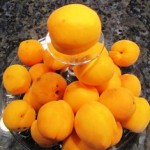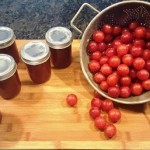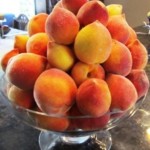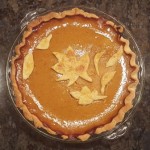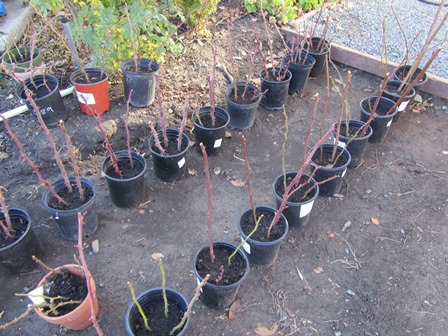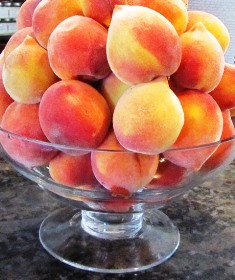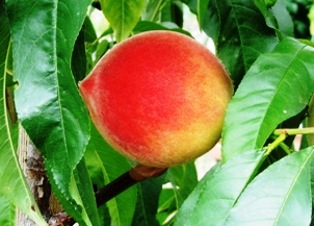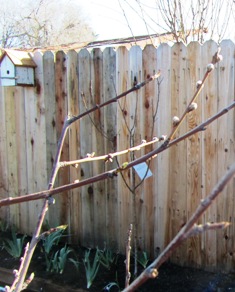Late to Ripen But Oh, So Yummy!
Following the historic long seasonal deluge of rain, our fruit trees are loaded with peaches, apricots, plums (the cherries are gone now). While there is plenty of stone fruit, it’s all ripening late this year.
Our Blenheim apricots were ready to pick, dry, and make into jam in late May of 2018. On this last day in June, I plucked an apricot that was ripe on the side facing the sun but the opposite side was green and hard.
The cherries, too, ripened late this year. We picked about 8 gallons of cherries from our two Bing and Stella trees. I dried some and we gave away a lot.
The Black Tartarian cherries didn’t produce as heavily this year as last. By the time we discovered the ripe cherries, the birds had already beaten us to the super-sweet fruit. I don’t mind sharing with the local wildlife, but would have loved a bowl of these for snacking.
The yellow and red plums are finally ripe now. Today, I’m making plum jam. Nothing beats hot toast with spreadable summer jams and marmalade for breakfast on a winter’s day. In a normal year, most of my jam-making of stone fruits would be finished by now.
The early Desert Gold peaches are gone now, a tasty memory, from a month ago. However, we still have summer peaches clinging to the tree. I check them daily. Fresh peach pie for the fourth of July is a favorite at my house.
While the fruits and berries seem to ripen more slowly this year, my vegetable garden is blowing my mind. I have several raised beds in a fenced-off area so wild animals won’t bother it. Most of the raised beds were used for composting (think, tons of chicken manure, yard clippings, and cardboard). Still, I added other organic amendments. Boy, is that soil paying off.
It’s a banner year for vegetables on the farmette. Most will be eaten fresh but the sugar pumpkins won’t ripen until autumn. Love them in pie.
_____________________________________________________________________________________
I’ve been told I’m living a “charmed life” on my Henny Penny Farmette. And so it is. But this chapter of my life didn’t happen by accident. I once lived in Silicon Valley and was part of life in the fast lane, which I enjoyed. But I grew up on a farm. I missed time in nature, eating foods that I knew were healthy and wholesome and pesticide-free, and the slower pace of life. I set an intention to manifest the life I have now. You can, too.
FIND ME ALSO at Meera-lester.com (don’t forget that hyphen…very important.)
If you enjoy reading about gardening, keeping chicken and bees, and other farm topics, pick up copies of my Henny Penny Farmette series of cozy mysteries. The books are chocked full of farm and craft trivia as well as delicious recipes and, of course, intriguing mysteries.
Pruning between Storms
The roses, fruit trees, vines, and bushes need pruning, I’ve been itching to get to them, but it’s been raining. Storms have been moving through but with breaks. With rain predicted well into February and March, I don’t think it’s a good idea to put off the pruning. Warm weather will start everything sprouting.
A Level 2 storm moved through today with high winds and rain. I waited until almost lunch time before venturing out. The winds are still fierce, but there are patches of blue in the sky. I filled pots with soil, took cuttings of my roses, dipped them into root hormone, and inserted several in each pot. These will become new bushes for the flower gardens out front of the house.
I love this time of year when the stack of seed catalogs grows daily and nurseries are gearing up for the bare-root season. Already my family is asking when can we plant spring peas, pointing out that the onions and garlic are up and the rhubarb root has set up new leaves.
I did a walk around recently and noticed that with all the rain and warm temperatures, my Desert Gold peach trees and the Bing and Black Tartarian cherries are covered with buds. The buds are swelling but no blossoms yet.
Grass and weeds are up nearly eight inches and growing like crazy. My lavender and the earliest bulbs are blooming. All this lovely growth seems weird after four long years of intense drought.
Even songbirds and honeybees seem happy as they flit around the farmette between the storms. Surely, these signs are harbingers for the glorious spring to come. All the more reason to get busy pruning between these storms.
Fresh Peaches Make Yummy Upside Down Cake
When our Desert Gold peach trees produced a few peaches at the end of May, we picked and ate all of them.
Now it’s the middle of July, and the Elberta peaches have ripened. Many have fallen from the tree. Over the last week, I picked most of those yellow-fleshed, honey sweet fruits and made peach preserves. With the remaining peaches hanging on the tree and about to drop, I am going to make a peach upside down cake.
The recipe looks long, but it is easy to follow and the cake is reminiscent of the upside down cake my grandmother used to make on her farm, located between Columbia and Booneville, in central Missouri. She always served it with homemade ice cream, made from fresh (cow’s milk) cream. For a quick substitute, you can use a quality vanilla ice cream to complement the taste of the warm peach cake.
Peach Upside Down Cake
Ingredients:
Three to four large peaches, peeled, stone removed, and sliced to produce 2 cups of fruit
½ cup light brown sugar, packed
1 teaspoon cinnamon
3 Tablespoons butter
1 ¾ cup all-purpose white flour
¼ teaspoon of salt
2 teaspoons baking powder
½ teaspoon cinnamon
½ cup butter (room temperature)
¾ cup granulated sugar
2 large eggs
½ teaspoon vanilla extract
¼ teaspoon almond extract
2/3 cup milk
Directions:
Preheat oven 325 degrees Fahrenheit
Grease a 9-inch square cake pan with butter.
Wash, peel, and remove pits of peaches; cut peaches into thin slices.
Combine brown sugar, 1 teaspoon of cinnamon, and 3 Tablespoons melted butter.
Add the peaches and toss to coat.
Arrange the peach mixture in the prepared baking pan.
Directions for making the cake batter:
Combine the flour, salt, baking powder, and ½ teaspoon cinnamon in a bowl.
Cream butter and sugar in a separate bowl and add eggs, vanilla extract, and almond flavoring.
Beat until well mixed.
Add the flour mixture to the creamed butter and sugar mixture, alternating with the milk, beating after each addition to blend.
Assembling:
Spoon the cake batter over the peach slices taking care to spread evenly until peaches are all covered.
Bake for 55 to 65 minutes. A toothpick inserted in the center of the cake should come out clean.
Remove from oven and invert onto a cake plate. Allow 5 minutes for the cake to pull away from the pan and drop onto the plate. Then gently remove the cake pan. Scrape any peach slices stuck in the pan onto top of cake.
Serves six.
Growing Palate-Pleasing Peaches
In the orchard area of the Henny Penny Farmette, we’ve planted several fruiting peach trees. Today, during this first full week in February, the Desert Gold peach trees (Prunus persica) broke into bloom.
These trees are more tolerant of heat than some of the varieties, but if planted in the desert Southwest or even in the hot interior valleys of California, the peach trees will perform better if given a little afternoon shade.
There are basically four types of peach trees: fruiting, flowering, combination fruiting and flowering, and dwarf. All peaches require heat during the hot weather months of their growing cycle and won’t properly set many blooms or be well pollinated during springs that are cold and wet. These trees also need some chilling during the winter months when they drop their leaves and go dormant.
We’ve discovered that our peach trees benefit from regular feedings (I’ve used fish emulsion tea, manure tea, and even chicken manure worked into the soil around the base of the tree) two or three times a year. For mature trees, plan on cutting away 2/3 of the previous year’s growth or cut each branch back about 1/3 it’s total length.
The Internet has some great videos that demonstrate how to properly prune your peach trees.
If you’ve prune your peach tree properly, you’ll have lovely, large fruits. Another technique to increase fruit size is to thin the number of fruits on the tree. Taking away some of the smaller fruits and reducing the size of the crop means that the remaining fruit can enlarge before ripening.
Peach leaf curl, peach leaf borer, and scale insects are pesky problems for peach growers and gardeners. Treatment requires spraying with Bordeaux mixture or lime sulfur twice a year. Nurseries suggests you spray your peach trees in November and again just before the buds swell.
Now, our trees are ready to flower, be pollinated by the honeybees, and produce some luscious peaches by the end of May. I’ll use the ripe peaches to make some palate-pleasing jams.
 Facebook
Facebook Goodreads
Goodreads LinkedIn
LinkedIn Meera Lester
Meera Lester Twitter
Twitter



